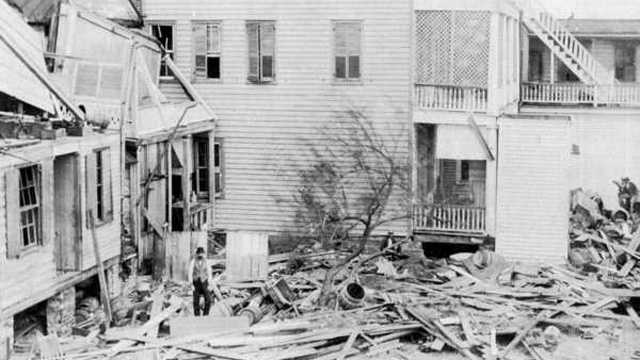- Get link
- X
- Other Apps
5 Worst Hurricanes in United States History
Hurricanes
are tropical cyclones formed from rapidly rotating storm system with a
low pressure center. The season for hurricanes in the Atlantic Ocean and
the Gulf of Mexico is considered to be June 1st until November 30th of
each year.
Hurricanes can be anything from a mild inconvenience to a living nightmare for those in its path. The following are ten hurricanes which turned into the latter.
Hurricanes can be anything from a mild inconvenience to a living nightmare for those in its path. The following are ten hurricanes which turned into the latter.

Great Galveston Hurricane | Source
1. The Great Galveston Hurricane of 1900
Indisputably,
the Great Galveston Hurricane of 1900 was the deadliest hurricane to
hit the nation's shores. The storm made landfall on September 8 as a
Category 4 storm with 143 miles per hour winds.
The people of Galveston had no warning they were in the direct line of the storm until the evening before the hurricane hit the island-city with 15 feet waves. These powerful storm surges knocked building off their foundation and destroyed more than 3,600 homes. The estimated costs of damages by today's standards was more than $496 million. An estimated 8,000 lives were lost to this deadly storm.
The people of Galveston had no warning they were in the direct line of the storm until the evening before the hurricane hit the island-city with 15 feet waves. These powerful storm surges knocked building off their foundation and destroyed more than 3,600 homes. The estimated costs of damages by today's standards was more than $496 million. An estimated 8,000 lives were lost to this deadly storm.
2. Okeechobee Hurricane of 1928
The
Okeechobee Hurricane, also known as San Felipe Segundo hurricane, is
Puerto Rico's deadliest hurricane in their history but was beat out by
Galveston in America.
Okeechobee
landed as a Category 4 storm in West Palm Beach during the early hours
of September 17 powered by winds as high as 146 miles per hour. More
than 2,500 lives were lost and an estimated $342 million (by today's
standards) in damages.
The storm weakened significantly after unleashing it's wrath on southern Florida and traveled up the eastern seaboard. When it was over, Okeechobee had claimed 4,079 men, women, and children and caused $1.3 billion (today's scale) in damages.
The storm weakened significantly after unleashing it's wrath on southern Florida and traveled up the eastern seaboard. When it was over, Okeechobee had claimed 4,079 men, women, and children and caused $1.3 billion (today's scale) in damages.
3. Hurricane Katrina of 2005
Hurricane
Katrina landed in New Orleans, Louisiana, as a Category 5 storm. As
the storm had traveled across Florida, it has slowed and weakened;
however, fueled by the warm air of the Gulf, the storm came back with a
vengeance. As 175 miles per hours winds hit New Orleans, 16 feet storm
surges would beat against the city's levees before moving on to reign
chaos among the other Gulf Coast cities in Mississippi and Alabama.
Those levees would become a great point of contention following the storm's aftermath. Allegations of lack of maintenance and misappropriation of funds would be addressed by politicians with an agenda and debated by the talking heads of the mainstream media.
As the blaming and bickering ensued, stunned Americans watched the death total rise to more than 1,800 men, women, and children and causing an estimated $134 billion (2016 USD) in damages.
Those levees would become a great point of contention following the storm's aftermath. Allegations of lack of maintenance and misappropriation of funds would be addressed by politicians with an agenda and debated by the talking heads of the mainstream media.
As the blaming and bickering ensued, stunned Americans watched the death total rise to more than 1,800 men, women, and children and causing an estimated $134 billion (2016 USD) in damages.
4. Chenière Caminada Hurricane of 1893
Located
in what is today Jefferson Parrish, the island of Chenière Caminada was
devastated by the 135 mile per hour winds and 16 feet high storm surges
during the early morning of October 2, 1893. Homes and business were
destroyed and 779 of the town's 1500 residents were killed in the storm.
After destroying Chenière Caminada, the storm moved on to wreck havoc on the other Gulf Coast states of Mississippi, Alabama, and Florida. When the storm dissipated on October 5, two thousand were dead and there was an estimated $118 million (2016 USD) in damages.
After destroying Chenière Caminada, the storm moved on to wreck havoc on the other Gulf Coast states of Mississippi, Alabama, and Florida. When the storm dissipated on October 5, two thousand were dead and there was an estimated $118 million (2016 USD) in damages.
5. Sea Islands Hurricane of 1893
The
second deadliest of three devastating hurricanes to hit America's
coastline during the 1893 season was the Sea Island Hurricane which made
landfall in Savannah, Georgia on August 27, 1893 with 120 miles per
hour winds. Storm surges as high as 18 feet were recorded.
Many residents of Sea Island, an outlying island near the Georgia-South Carolina border, had anticipated a severe storm and had evacuated the island. Still the storm claimed the lives of an estimated 2,000 people. Property damages were estimated at more than $25 million (2016 USD).
Many residents of Sea Island, an outlying island near the Georgia-South Carolina border, had anticipated a severe storm and had evacuated the island. Still the storm claimed the lives of an estimated 2,000 people. Property damages were estimated at more than $25 million (2016 USD).
- Get link
- X
- Other Apps





Comments
Post a Comment